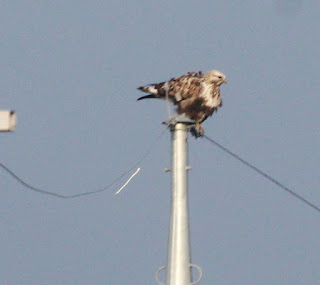 |
| Surreal Seosan |
 |
| Near Jiri-san |
 |
| Subs and Loghry scanning Lapland Longspurs amidst the stubble |
 |
| Eurasian Bittern Botaurus stellaris |
 |
| Common Kestrel Falco tinnunculus |
 |
| Long-billed Dowitcher Limnodromus scolopaceus |
Long-billed Dowitcher Limnodromus scolopaceus
 |
| Tundra Swan Cygnus columbianus (left) with Whooper Swan Cygnus cygnus |
 |
| Cloud of Lapland Longspurs (Calcarius
lapponicus) - a very satisfying name to say...try it |
 |
| Distant Lapland Longspur Calcarius
lapponicus |
On November 28-29, I met up with two good friends, Loghry and Subho, for a grueling
yet amazing weekend of birding at a huge site still full of birding potential,
in spite of signs of trouble everywhere (concrete...construction...). We ended up logging 66 species for the
weekend, with several surprises among them. Saturday was dim and overcast, with chilly temperatures hovering around
freezing, and snow from earlier in the week still covering most of the
landscape.
On a weekend with many highlights, some bird encounters
nevertheless stood out as noteworthy. We
soon caught up with one of our target species, as 300-400 Lapland Longspurs
shimmered restlessly across the landscape in undulating flocks, before coming
to land in the fields. They vanished
amidst the stubble and skulked among
the furrows like mice upon landing, never giving very close looks. Soon after that encounter, we spotted two Tundra
Swans mixed up with at least a hundred Whooper Swans, and we spent a long time
comparing the two similar species.
Several hours later, in a memorable and serendipitous
birding moment, we pulled the car over next to a man-made pond to have a brief
snack, as the rain started up again. While we were eating, all three of us casually looked to the right at
the same time and saw a motionless shorebird on a spit of mud several metres
from the car. Looking like a ‘Grey-tailed
Tattler with issues’ at first glance, we stared at the bird in silent confusion
for several seconds before starting to put the pieces of the puzzle
together. It had to be...but it couldn’t
be...it WAS...a Long-billed Dowitcher! A
most welcome and unexpected encounter with this less than annual vagrant.
Other notable target birds we spent time with included a Chinese
Grey Shrike, a Lesser White-fronted Goose, and three Eurasian Bitterns. Geese were everywhere this weekend, with at
least 5,000 Bean and Greater White-fronted Goose seen in and over the fields at
all times. The most abundant raptor was Eastern
Buzzard, with at least 19 seen over the weekend - several reddish individuals
among them. A handful of Common Kestrels and Northern
Goshawks were seen patrolling the fields, as well as three Hen Harriers. Multiple flocks of 30-60 Grey-capped Greenfinch
and Brambling were seen near villages and lightly wooded areas, and lone Dusky
and Naumann’s Thrushes in the same tree was an interesting sight. Yellow-throated, Rustic, and Black-faced Buntings
were also present in most scrubby areas.
On the 29th, the skies were still overcast, and
the temperatures were warmer (with most of the snow melting) with intermittent rain. The day was also a much quieter one,
bird-wise. In the late morning, a Snow
Goose was spotted with several hundred Bean and Greater White-fronted Geese
near Seosan Birdland. None of the
busloads of visitors to this tourist trap took note of the spectacle of wild
geese within a stone’s throw of the parking lot. The visitors we saw were more interested in
frightening a caged one-winged Cinereous Vulture and quivering Northern Goshawk
by dancing (to the music being pumped out of speakers) and shouting in front of
the cages, then laughing when the birds got agitated. These birds, along with a captive Eurasian Eagle Owl
and Peregrine Falcon among others, were a pitiful and depressing sight indeed. For those interested in ‘birding’, several oversized
fibreglass Hooded Cranes had been planted in a field for guests to look at
through scopes. An enclosure next to
Birdland held hundreds of Mandarin Ducks in cramped quarters, for some reason. This situation definitely merits further
investigation. All in all, this place
felt like a poorly thought out and grim attempt to soak up tourist money.





























